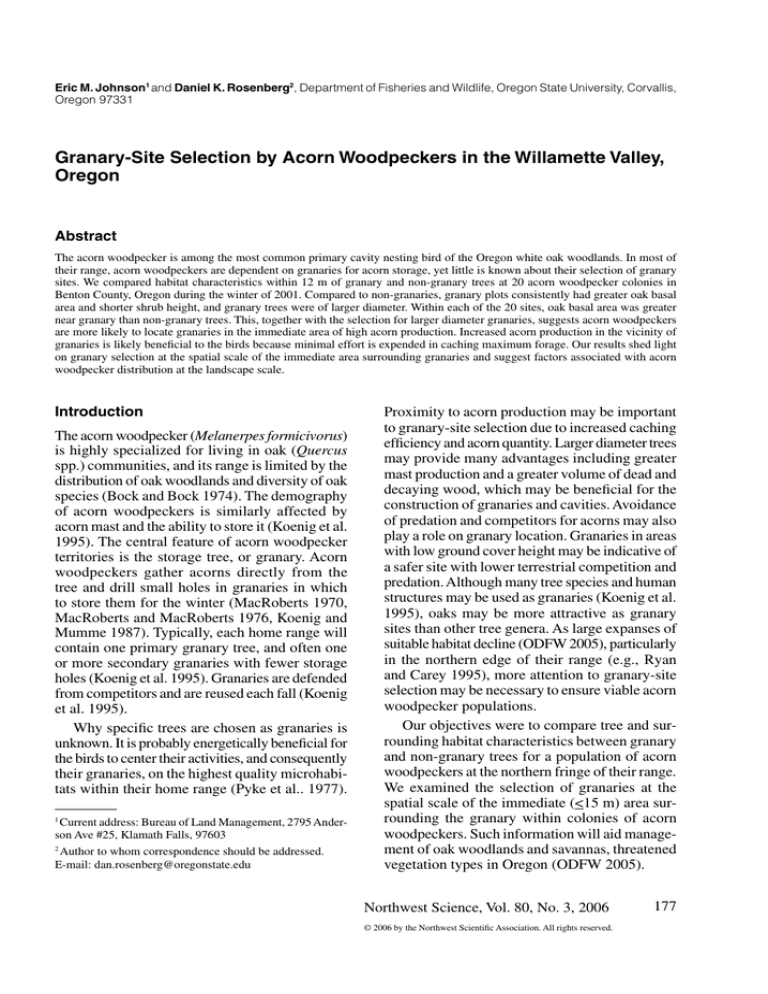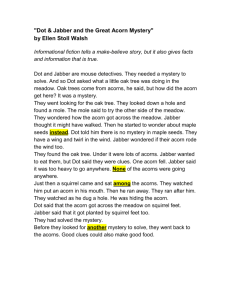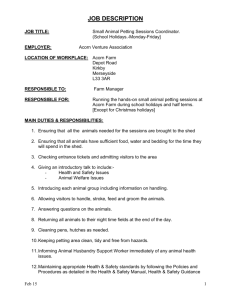
Eric M. Johnson1 and Daniel K. Rosenberg2, Department of Fisheries and Wildlife, Oregon State University, Corvallis,
Oregon 97331
Granary-Site Selection by Acorn Woodpeckers in the Willamette Valley,
Oregon
Abstract
The acorn woodpecker is among the most common primary cavity nesting bird of the Oregon white oak woodlands. In most of
their range, acorn woodpeckers are dependent on granaries for acorn storage, yet little is known about their selection of granary
sites. We compared habitat characteristics within 12 m of granary and non-granary trees at 20 acorn woodpecker colonies in
Benton County, Oregon during the winter of 2001. Compared to non-granaries, granary plots consistently had greater oak basal
area and shorter shrub height, and granary trees were of larger diameter. Within each of the 20 sites, oak basal area was greater
near granary than non-granary trees. This, together with the selection for larger diameter granaries, suggests acorn woodpeckers
are more likely to locate granaries in the immediate area of high acorn production. Increased acorn production in the vicinity of
granaries is likely beneficial to the birds because minimal effort is expended in caching maximum forage. Our results shed light
on granary selection at the spatial scale of the immediate area surrounding granaries and suggest factors associated with acorn
woodpecker distribution at the landscape scale.
Introduction
The acorn woodpecker (Melanerpes formicivorus)
is highly specialized for living in oak (Quercus
spp.) communities, and its range is limited by the
distribution of oak woodlands and diversity of oak
species (Bock and Bock 1974). The demography
of acorn woodpeckers is similarly affected by
acorn mast and the ability to store it (Koenig et al.
1995). The central feature of acorn woodpecker
territories is the storage tree, or granary. Acorn
woodpeckers gather acorns directly from the
tree and drill small holes in granaries in which
to store them for the winter (MacRoberts 1970,
MacRoberts and MacRoberts 1976, Koenig and
Mumme 1987). Typically, each home range will
contain one primary granary tree, and often one
or more secondary granaries with fewer storage
holes (Koenig et al. 1995). Granaries are defended
from competitors and are reused each fall (Koenig
et al. 1995).
Why specific trees are chosen as granaries is
unknown. It is probably energetically beneficial for
the birds to center their activities, and consequently
their granaries, on the highest quality microhabitats within their home range (Pyke et al.. 1977).
Current address: Bureau of Land Management, 2795 Anderson Ave #25, Klamath Falls, 97603
2
Author to whom correspondence should be addressed.
E-mail: dan.rosenberg@oregonstate.edu
1
Proximity to acorn production may be important
to granary-site selection due to increased caching
efficiency and acorn quantity. Larger diameter trees
may provide many advantages including greater
mast production and a greater volume of dead and
decaying wood, which may be beneficial for the
construction of granaries and cavities. Avoidance
of predation and competitors for acorns may also
play a role on granary location. Granaries in areas
with low ground cover height may be indicative of
a safer site with lower terrestrial competition and
predation. Although many tree species and human
structures may be used as granaries (Koenig et al.
1995), oaks may be more attractive as granary
sites than other tree genera. As large expanses of
suitable habitat decline (ODFW 2005), particularly
in the northern edge of their range (e.g., Ryan
and Carey 1995), more attention to granary-site
selection may be necessary to ensure viable acorn
woodpecker populations.
Our objectives were to compare tree and surrounding habitat characteristics between granary
and non-granary trees for a population of acorn
woodpeckers at the northern fringe of their range.
We examined the selection of granaries at the
spatial scale of the immediate (<15 m) area surrounding the granary within colonies of acorn
woodpeckers. Such information will aid management of oak woodlands and savannas, threatened
vegetation types in Oregon (ODFW 2005).
Granary Science,
SelectionVol.
by Acorn
Northwest
80, No.Woodpeckers
3, 2006
© 2006 by the Northwest Scientific Association. All rights reserved.
177
Study Sites
We conducted the study within Benton County of
western Oregon (Figure 1). This portion of the Willamette Valley is mostly flat, low elevation (~100
m) and dominated by agricultural and suburban
uses. The climate is mild with wet winters and
warm, dry summers (Franklin and Dyrness 1973).
We sampled habitat characteristics from 20 acorn
woodpecker colonies chosen from those identified by Doerge (1979) and unpublished Oregon
Department of Fish and Wildlife surveys, and by
searching oak woodlands from nearby roads with
binoculars (Figure 1). All were dominated by
Oregon white oak (Quercus garryana) and were
near modified grasslands, including fields of grass
Figure 1. Location of acorn woodpecker study sites (n=20) within Benton County, Oregon. Acorn woodpecker
sites are indicated by a solid circle. Inset indicates location of Benton County (shaded) within Ore­
gon.
178
Johnson and Rosenberg.
seed crops. Douglas-fir (Pseudotsuga menziesii),
giant sequoia (Sequiadendron giganteum), and
bigleaf maple (Acer macrophyllum) were the only
other trees present.
Methods
We located granaries by walking through acorn
woodpecker colonies and searching with binoculars
for the birds and their granaries during the winter
months (January-April) of 2001 when the trees
lacked leaves and the woodpeckers were actively
feeding upon cached acorns. We recorded the
position of the main granary (defined below) or
the center of storage activity when there was no
obvious main granary.
We defined the foraging range of each woodpecker group by the location of the main granary.
Following Koenig and Mumme (1987), we defined
the main granary as the largest consistently guarded
cache, and a primary foraging range as the area
within a 50-m radius from the main granary. We
considered 50 m as our operational definition of
the primary foraging range because it contained
all granaries in most colonies. Three non-granary
trees and three granary trees within the primary
foraging range were selected for measurement by
randomly selecting a universal transverse mercator
(UTM). The random UTM was selected using a
random distance (δ) weighted towards the exterior
(to give equal probability for the entire foraging
range) according to
c1 ,
d = 50√
and a random angle (α) was generated according to
a = 360c2 ,
where χ1 and χ2 were randomly generated numbers
between 0 and 1. Therefore, δ was the distance
in meters from the main granary, and α was the
bearing (in degrees east of true north) from which
the distance was measured. The nearest tree or
snag >20 cm diameter at breast height (dbh) was
selected if within 5 m of the random location.
We continued to select random locations until we
had located three granary and three non-granary
trees.
We described characteristics of granary and
non-granary trees and the area surrounding them.
At each of the randomly selected granary and
non-granary trees (hereafter referred to as “reference tree”), we recorded tree type (oak, conifer,
deciduous non-oak), whether the tree was alive
or dead, and dbh. We measured dbh of all oak
trees >20 cm dbh within 12 m of the reference
tree (granary or non-granary) and added these
measurements to estimate oak basal area. We used
12 m because acorns are usually gathered from
within that distance of the granary (Nicpon 1995;
E. Johnson, personal observation). We chose 20
cm dbh as the minimum size to include because
oaks rarely produce mast until achieving this size
(Goodrum et al.1971, Peter and Harrington 2002).
Shrub height in the immediate area of the granary
and non-granary trees was estimated by measuring
the maximum height within four 1-m-diameter
circles, with each center 3 m from the reference
tree in each of the four cardinal directions (Higgins and Barker 1982).
We calculated mean dbh (reference trees), oak
basal area, and shrub height for the three granary and
three non-granary plots in each of the 20 colonies.
We then computed the difference between the mean
values for granary and non-granary plots within each
site (χ*), and used these 20 differences (­granary–
non-granary) in paired t-tests (Proc Means; SAS
Institute 1998). We report the mean difference, its
associated SE, and the P-value, the probability of
the observed data given the null hypothesis of no
difference (χ* = 0). We also report the mean and SE
of habitat characteristics of granary and non-granary
plots with all sites pooled, rather than paired by
site, and we qualitatively compared these results
with those from the paired differences.
Results
Oregon white oak was by far the most abundant
tree species in our sites and other tree species were
relatively uncommon or absent from the plots.
All of the randomly selected granary trees were
living oaks, although we observed granaries in
bigleaf maple and giant sequoia within the study
sites. Granaries were also observed in a utility
pole and on the side of a house. The randomly
selected non-granary trees were white oak (87%),
Douglas fir (5%), and big-leaf maple (8%). Two
of the non-granary trees were snags.
The predominant difference between granary
and non-granary plots was oak basal area, which
was consistently much higher in granary plots. Oak
basal area was almost twice as great at granary
(50.1 ± 4.1 m2/ha) than at non-granary (27.2 ± 3.0
m2/ha) plots (Figure 2A), with an average differGranary Selection by Acorn Woodpeckers
179
Figure 2. Box-and-whisker diagrams of oak basal area (m2/ha), dbh (cm) of randomly selected granaries or non-granaries, and
shrub height (cm) at 20 acorn woodpecker sites, Benton County, Oregon. Oak basal area and shrub height were sampled
from within 12-m of the granary or non-granary tree; DBH is that of the reference tree. The median and mean are shown
as the solid and dotted line, respectively, within the box, and the box contains the 25th to 75th percentile of observations.
The error bars indicate the 10th and 90th percentile. Outlying points are shown as filled circles. (A) Comparison of the
distribution among the mean values from 3 plots at each of the 20 sites. The y-axis is the unit of measurement as indicated above for each variable. (B) Differences (granary – non-granary plots) of dbh (reference trees), oak basal area,
and shrub height were computed from the mean values of the 3 granary and 3 non-granary plots within each site.
Figure 3. Diameter at breast height (dbh) distribution of
Oregon white oak trees within 12-m sample plots
surrounding granary and non-granary reference
trees. The mid-point of the interval class is shown
on the x-axis; 20 cm dbh was the smallest tree included in the samples. The number of trees, pooled
from the 3 12-m plots from each of the 20 sites is
shown on the histogram.
180
Johnson and Rosenberg.
ence within sites (χ*) of 23.0 ±
3.5 m2/ha (P<0.001; Figure 2B).
Although the basal area of oaks
overlapped between granary and
non-granary plots when considering all sites pooled (Figure
2A), there was no overlap within
any particular site (Figure 2B).
Patterns of diameter distribution of Oregon white oaks was
similar between the pooled granary and non-granary plots, with
few very large (>80 cm dbh)
trees within the sample plots
(Figure 3). Shrub height was
shorter in granary (18.5 ± 4.3
cm) than non-granary (45.0 ±
9.5 cm) plots, with an average
paired difference of -26.0 ± 7 cm
(P=0.001; Figure 2). Diameter
at breast height of reference trees was greater
at granaries (64.7 ± 4.7 cm) than non-granaries
(53.5 ± 5.5 cm); the paired difference was 11.3
± 3.8 cm (P=0.008; Figure 2). The differences
were greater in all of these characteristics when
comparing granary and non-granary plots within
a site (Figure 2B) than among sites (Figure 2A).
Shrub height was negatively correlated with oak
basal area (-0.62, P = 0.0035), as expected for
oak savanna habitats where oak was the dominant
over-story cover.
Discussion
We found that granaries were generally the larger
oak trees with low surrounding shrub height and
were consistently associated with areas of greater
basal area of Oregon white oak. We speculate that
this is because of acorn production, reflecting the
importance of acorns to the bird’s demography,
particularly for winter survival and spring reproduction (Koenig et al. 1995). Although insects
are a critical part of the acorn woodpecker’s diet,
availability of acorn mast drives their demography
in most populations (Koenig et al. 1995).
If acorn woodpeckers are behaving in a manner
consistent with optimal foraging theory (Pyke et
al. 1977), granaries should be located centrally in
the major acorn-producing area within the home
range. This would allow for minimal expenditure
of energy per acorn. If this is true, habitat directly
around the granaries is expected to have greater
acorn production relative to other portions of
the home range. Our findings of a greater difference of oak basal area between the granary and
non-granary plots within a site than the pooled
means across all sites, suggest that woodpeckers
selected the granary location with the greatest
basal area within its home range more than it
selected a specific basal area. Oregon white oak
acorn production generally increases as basal
area increases (Goodrum et al. 1971), but as Peter and Harrington (2002) documented for acorn
­production of Oregon white oaks, per capita
production is greatest when stand density is low
and oaks are at least 60-80 yr. In northwestern
California, Raphael (1987) demonstrated that
acorn woodpeckers were positively associated
with tanoak (Lithocarpus densiflora) canopy
volume and mast production. Indeed, all of the
granary plots we sampled had greater basal area
of oaks than non-granary plots within the same
site. The mean basal area that we observed within
sites was greater than that reported by Peter and
Harrington (2002), suggesting that trees were
not at maximum per capita production. As Peter
and Harrington (2002) point out, there is a need
for a better understanding of the trade off of per
capita and stand-level acorn production to guide
effective management.
Because the Oregon white oak is the only
native oak species in Benton County and the
predominate species in the Willamette Valley,
acorn woodpeckers likely experience a great deal
of fluctuation in forage availability. Acorn production may be more consistent in areas of greater
oak species diversity because of the asynchronous
annual masting among different oak species. This
led Bock and Bock (1974) to hypothesize that
oak diversity may limit the distribution of acorn
woodpeckers. Acorn production by Oregon white
oak is cyclical (Sudworth 1967, Coblentz 1980),
with high yields of acorn crops occurring every
3-6 years (Ryan and Carey 1995). During years
of low acorn production, acorn woodpeckers in
the Willamette Valley likely experience a great
deal of winter mortality, although we are unaware
of demographic data to evaluate this hypothesis.
Consequently, acorn production probably limits
population size in the Willamette Valley, as it does
in other regions (Hannon et al. 1987, Koenig and
Mumme 1987; Koenig et al. 1995).
Competition for acorns and predator avoidance
may also be important influences in granary-site
selection. Competition for nesting cavities and
acorns, as well as predation comes from both terrestrial and aerial sources (Neff 1928, Troetschler
1976, Koenig et al. 1995, Nicpon 1995). This may
lead to the selection of sites that are more defensible, less desirable for competitors and predators, and that have greater escape opportunities.
Our finding of lower shrub height near granaries
was consistent with this hypothesis; however, it
is possible this finding was partially due to the
negative correlation with oak basal area. Although
correlated, shrub height was clearly dependant
upon vegetation management of the site (e.g.
mowing & grazing) rather than simply under-story
suppression (E. Johnson, pers. obs.).
Because the acorn woodpecker is highly dependent upon the presence of masting oaks,
management of these trees is likely to greatly
affect the birds that depend upon them. The oak
woodland-savanna vegetation in the Willamette
Valley has declined in area to less than 15%
of its pre-settlement extent (Pacific Northwest
Ecosystem Consortium 1998) due to conversion to agriculture, succession to a Douglas-fir
dominated forest, and unprecedented urban and
suburban development (Towle 1983, Cambell
2004, Vesely and Tucker 2004). Further, most of
white oak woodlands have high density of oaks
Granary Selection by Acorn Woodpeckers
181
(Vesely and Tucker 2004). Although such stands
may have a high basal area, they result in low acorn
production (Peter and Harrington 2002) and thus
presumably fewer beneficial granary locations.
Our sample included only sites in which acorn
woodpeckers foraged. In these sites, tree density
was moderate and contained a large number of midsize trees (40-80 cm dbh; Figure 3). The relative
role of acorn production versus stand structure,
per se, in acorn woodpecker foraging ecology is
not known. Thinning dense stands to create larger
diameter and more productive masting trees (Peter
and Harrington 2002) will likely benefit acorn
woodpeckers by creating potential granary sites
with high acorn production, but the trade-off with
lower basal area will need to be addressed. Our
findings can be used as a basis for stand density
management for acorn woodpeckers, although the
relationship of size distribution and stand density
on acorn woodpecker foraging ecology requires
research conducted at larger spatial scales.
Acknowledgements
. Literature Cited
micivorus). The birds of North America, number 194.
The American Ornithologist’s Union. Washington,
D.C., and National Academy of Sciences, Philadelphia,
Pennsylvania.
MacRoberts, M. H. 1970. Notes on the food habits and food defense of the acorn woodpecker. Condor 72:196-204.
MacRoberts, M. H. and B. R. MacRoberts. 1976. Social organization and behavior of the acorn woodpecker in
central coastal California. Ornithological Monograph
21:1-115.
Neff, J. A. 1928. A study of the economic status of the common woodpeckers in relation to Oregon horticulture.
Free Press Print. Marionville, Michigan.
Nicpon, B. D. 1995. Influences of feeding stations on scrub
jay kleptoparasitism at acorn woodpecker granaries.
M.S. Thesis, Southern Oregon University, Ashland,
Oregon.
ODFW (Oregon Department of Fish and Wildlife). 2005.
Oregon’s comprehensive wildlife conservation strategy. Oregon Department of Fish and Wildlife, Salem, Oregon.
Pacific Northwest Ecosystem Research Consortium. 1998.
Willamette River Basin: A planning atlas. Institute for
a Sustainable Environment, Eugene, Oregon.
Peter, D., and C. Harrington. 2002. Site and tree factors in
Oregon white oak acorn production in western Washington and Oregon. Northwest Science 76:189-201.
Pyke, G. H, H. R. Pulliam, and E. L. Charnov. 1977. Optimal
foraging: a selective review of theory and tests. Quarterly Review of Biology 52:137-154.
Raphael, M. G. 1987. Wildlife-tanoak associations in Douglasfir forests of northwestern California. USDA Forest
Service General Technical Report PSW-100. Pacific
Southwest Forest and Range Experiment Station,
Berkeley, California.
Bock, C. E., and J. H. Bock. 1974. Geographical ecology of
the acorn woodpecker: diversity versus abundance of
resources. American Naturalist 108:1298-1300.
Cambell, B. H. 2004. Restoring rare native habitats in the
Willamette Valley. Defenders of Wildlife, Washington, D.C.
Coblentz, B. E. 1980. Production of Oregon white oak acorns
in the Willamette Valley, Oregon. Wildlife Society
Bulletin. 8:348-350.
Doerge, K. F. 1979. Aspects of the geographic ecology of
the acorn woodpecker. M.S. Thesis, Oregon State
University, Corvallis, Oregon.
Franklin, J., and C. Dyrness. 1973. Natural vegetation of Oregon and Washington. USDA Forest Service General
Technical Report PNW-8. Pacific Northwest Forest and
Range Experiment Station, Portland, Oregon.
Goodrum, P. D., V. H. Reid, C. E. Boyd. 1971. Acorn yields,
characteristics, and management criteria of oaks for
wildlife. Journal of Wildlife Management 35:521532.
Hannon, S. J., R. L. Mumme, W. D. Koenig, S. Spon, and F.
A. Pitelka. 1987. Poor acorn crop, dominance, and
decline in numbers of acorn woodpeckers. Journal of
Animal Ecology 56:197-207.
Higgins, K. F., and W. T. Barker. 1982. Changes in vegetation
structure in seeded nesting cover in the prairie pothole
region. US Fish and Wildlife Service special scientific
report: wildlife, number 242. Washington, D.C.
Koenig, W. D., and R. L. Mumme. 1987. Population ecology
of the cooperatively breeding acorn woodpecker.
Princeton University Press. New Jersey.
Koenig, W. D., P. B. Stacey, M. T. Stanback, and R. L.
Mumme. 1995. Acorn woodpecker (Melanerpes for-
182
Johnson and Rosenberg.
We thank the landowners that allowed access to
the sites. We are grateful to R. Goggans of the
Oregon Department of Fish and Wildlife for help
locating colonies; A. Azarenko and R. Schmitz for
constructive criticism of the research and resulting
manuscript; J. Gervais, S. Schwab, E. Schreiner,
D. Vesely, and two anonymous reviewers for
constructive criticisms of the manuscript; and the
Bioresource Research program for support for E.
Johnson. This work was made possible by funds
provided to E. M. J. by The Oregon Chapter of
The Wildlife Society’s undergraduate research
scholarship and support from the University
Honors College, Oregon State University. Publication costs were supported by the Thomas G.
Scott Publication Fund and the Herb Summers
Memorial Scholarship Endowment to support
BioResource Research Interdisciplinary program
student scholarship.
Ryan, L., and A. Carey. 1995. Biology and management
of the western gray squirrel and Oregon white oak
woodlands: with emphasis on the Puget Trough.
General Technical Report PNW-GTR-348. Portland,
Oregon. Pacific Northwest Research Station, Forest
Service, USDA.
SAS Institute. 1998. Version 7. SAS Institute, Cary, North
Carolina.
Sudworth, G. B. 1967. Forest trees of the Pacific slope. Dover
Publications. New York.
Towle, J. C. 1983. Changing geography of Willamette Valley
woodlands. Oregon Historical Quarterly 1:66-87.
Troetschler, R. G. 1976. Acorn woodpecker breeding strategy
as affected by starling nest-hole competition. Condor
78:151-165.
Vesely, D., and G. Tucker. 2004. A landowner’s guide for
restoring and managing Oregon white oak habitats.
Bureau of Land Management, Salem, Oregon.
Received 24 October 2005
Accepted for publication 14 July 2006
Granary Selection by Acorn Woodpeckers
183









